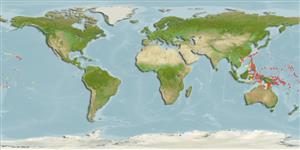Classification / Names
Common names | Synonyms | Catalog of Fishes (gen., sp.) | ITIS | CoL | WoRMS | Cloffa
Actinopterygii (ray-finned fishes) >
Perciformes (Perch-likes) >
Pseudochromidae (Dottybacks) > Pseudochrominae
Etymology: Pictichromis: Name from Latin pictus meaning painted or colored, and Greek Chromis, a genus of pomacentrid, used as the stem for other fish genera; alludes to the bright live colorations of the included species (Ref. 81967).
Environment / Climate / Range
Ecology
Marine; reef-associated; depth range 0 - 65 m (Ref. 9710), usually 0 - 15 m (Ref. 90102). Tropical; 24°C - 26°C (Ref. 27115), preferred ?; 30°N - 15°S
Western Pacific: Philippines to Samoa, north to Ryukyu Islands, south to Moluccas and Admiralty Islands.
Size / Weight / Age
Maturity: Lm ? range ? - ? cm
Max length : 6.0 cm TL male/unsexed; (Ref. 9710)
Hovers above coral or rubble and inhabits steep outer reef slopes and outer channel walls. Solitary or in small, loosely scattered groups at base of steep dropoffs (Ref 90102).
Life cycle and mating behavior
Maturity | Reproduction | Spawning | Eggs | Fecundity | Larvae
Myers, R.F., 1991. Micronesian reef fishes. Second Ed. Coral Graphics, Barrigada, Guam. 298 p. (Ref. 1602)
IUCN Red List Status (Ref. 115185)
CITES (Ref. 94142)
Not Evaluated
Threat to humans
Harmless
Human uses
Aquarium: commercial
More information
Common namesSynonymsMetabolismPredatorsEcotoxicologyReproductionMaturitySpawningFecundityEggsEgg development
ReferencesAquacultureAquaculture profileStrainsGeneticsAllele frequenciesHeritabilityDiseasesProcessingMass conversion
Tools
Special reports
Download XML
Internet sources
Estimates of some properties based on models
Phylogenetic diversity index (Ref.
82805): PD
50 = 0.5039 [Uniqueness, from 0.5 = low to 2.0 = high].
Bayesian length-weight: a=0.00490 (0.00190 - 0.01264), b=3.10 (2.88 - 3.32), in cm Total Length, based on LWR estimates for this (Sub)family-body shape (Ref.
93245).
Trophic Level (Ref.
69278): 3.5 ±0.50 se; Based on food items.
Resilience (Ref.
69278): High, minimum population doubling time less than 15 months ().
Vulnerability (Ref.
59153): Low vulnerability (10 of 100) .
